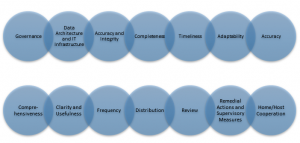
Interestingly, the Basel Committee’s Principles for Effective Risk Data Aggregation and Risk Reporting (otherwise known as BCBS 239) begins with a quote from T.S. Elliot’s The Rock:
Where is the wisdom we have lost in knowledge?
Where is the knowledge we have lost in information?
In this age of big data and risk data management, Elliot’s words from 1934 should not ring so true. But for the signatories of the Basel Accords, they peal painfully. Hopefully, what doesn’t get lost in this post-financial crisis regulation is that those words are significant—not to IT risk—but to risk IT.
The Basel Committee, in its revised Pillar 2 (supervisory review) guidance, states that, at the heart of a sound risk management system, is an appropriate management information system at the business and bank-wide level. Effective risk data aggregation and risk reporting cannot be accomplished without effective risk information technology for real-time or near real-time insights and strategic decision-making.
Global consultancy McKinsey & Company posits that business benefits from an appropriate MIS are lower losses, lower capital needs, lower operational risk costs and lower operational costs. These business benefits are obtained by better data quality, more accurate categorizations, more frequent updates, less manual effort, better fraud detection and better data management. In short, the better a bank’s risk IT is, the sooner these business benefits are attainable.
The BCBS 239 regulation has fourteen principles on which risk IT should be built. In the next few posts, my colleagues and I will explain the principles and the benefits of focusing on improving your risk IT. In post No. 1, Brooke Upton, Global Product Marketing Manager for Risk, SAS, will start us off with a discussion on governance.
Read how SAS can help you meet your regulatory obligations. SAS solutions provide an end-to-end framework for addressing and reporting on regulations, predefined stress-testing methodologies and preconfigured reporting capabilities.
